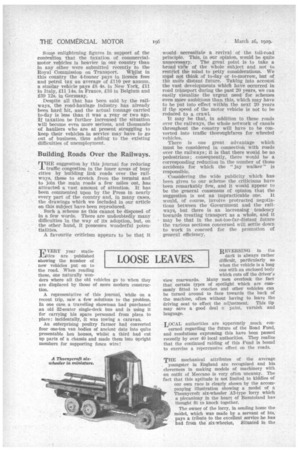THE
Page 47

Page 48

If you've noticed an error in this article please click here to report it so we can fix it.
CPNIMERCIAL
MOTOR Largest Circulation.
Conducted by EDMUND DANGERFIELD.
Combating the Excessive Taxation of Commercial Vehicles.
riURING the past few _years the burden of motor taxation as a whole, and that of the commercial motor in particular, has been increased to such an extent as to be grossly unfair and seriouslY to threaten the existence of the transport industry, which is vital to the business prosperity of this country.
The increase in the price of petrol resulting from direct taxation and the recent addition by the petrol combine have dealt further staggering blows cumulative in their effects, and it behoves all concerned in the business of transport by road to fight tooth and nail against further imposts.
The cost of roads in 1910 was slightly over £15,000,000, which is equivalent to-day to some £26,000,000. In 1926, the last year for which information has been published, the actual cost was £56,000,000, and the increase since the general introduction of motor vehicles (obtained by subtracting the pre-war cost from that for 1920) is under £80,000,000. It is futile to argue that motor vehicles either benefit solely by road improvements or that they are altogether responsible for the need for them.
It is estimated that, this year, the petrol tax will yield £13,000,000, and the direct taxation of motor vehicles nearly £26,000,000, giving a total of approximately £40,000,000. Consequently, motor vehicles are paying 110,000,000 per annum above the total increase in the annual cost of roads during the past 20 years.
For every 14 passengers carried in a London bus one is required to meet the burden of special motor taxation, whilst in the case of ft bus operating outside London the taxation represents 10 per cent. of its total revenue. As regards the transport of goods by road, the average amount which has to be paid is equivalent to Id. per net ton-mile.
It must be remembered that Government pledges were given that, except for certain administrative deductions, the revenue from motor taxation should be spent on theroads, yet, despite these, only 14 per cent, of the entire revenue is applied to important road improvements, and over 45 per cent. is wholly diverted from the roads. Some enlightening figures in support of the contention that the taxation of commercialmotor vehicles is heavier in our country than in any other were submitted recently to the Royal Commission on Transport. Whgst in this country the 4-tonner pays in licence fees and petrol tax an average of £110 per annum, a similar vehicle pays £8 4s. in New York, £11 in Italy, ill 14,s. in France, £16 in Belgium and 1.39 12s. in Germany.
Despite all that has been said by the railways, the road-haulage industry has already been hard hit, and the actual tonnage carried to-day is less than it was a year or two ago. If taxation be further increased the situation will become even more serious, and thousands of hauliers who are at present struggling to keep their vehicles in service may have to go out of business, thus adding to the existing difficulties of unemployment.
Building Roads Over the Railways.
THE suggestion by this journal for reducing traffic congestion in the inner areas of busy cities by building link roads over the railways, these to stretch from the termini and to join the main roads a few miles out, has attracted a vast amount of attention. It has been commented upon by the Press in nearly every part of the country and, in many cases, the drawings which we included in our article on this subject have been reproduced. Such a scheme as this cannot be disposed of in a few words. There are undoubtedly many difficulties In the way of its adoption, but, on the other hand, it possesses wonderful potentialities.
A favourite criticism appears to be that it would necessitate a revival of the toll-road principle. This, in our opinion, would be quite unnecessary. The great point is to take a broad Vielv of the whole subject and not to restrict the mind to petty considerations. We must not think of to-day or to-morrow, but of the more distant future. Taking into account the vast developments which have occurred in road transport during the past 20 years, we can easily visualize the urgent need for schemes even more ambitious than this, which may have to be put into effect within the next 20 years if the speed of the motor vehicle is not to be reduced to a crawl.
It may he that, in addition to these roads over the railways, the whole network of canals throughout the country will have to be converted into traffic thoroughfares for wheeled vehicles.
There is one great advantage which must be considered in connection with roads over the railways; it is that there would be no pedestrians ; consequently, there would be a corresponding reduction in the number of those accidents for which the "jay walker" is responsible.
Considerinr, the wide publicity which has been given to our scheme the criticisms have been remarkably few, and it would appear to be the general consensus of opinion that the suggestion is not an impracticable one. It would, of course, involve protracted negotiations between the Government and the railways, but there is an increasing tendency towards treating transport as a whole, and it may be that in the not-too-far-distant future the various sections concerned will settle dawn to work in concord for the promotion of general efficiency.




























































































































